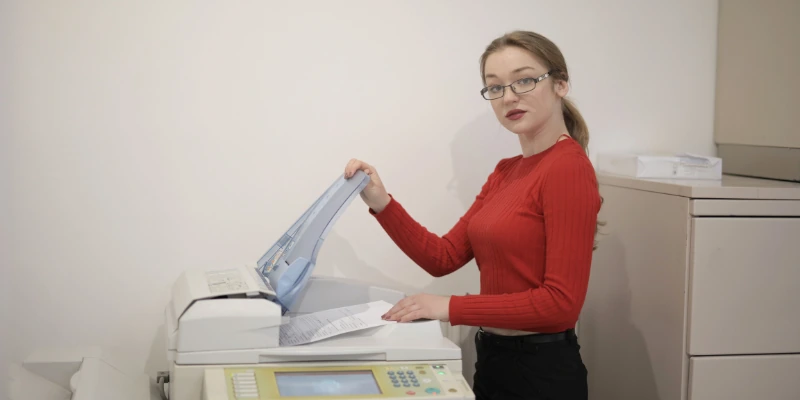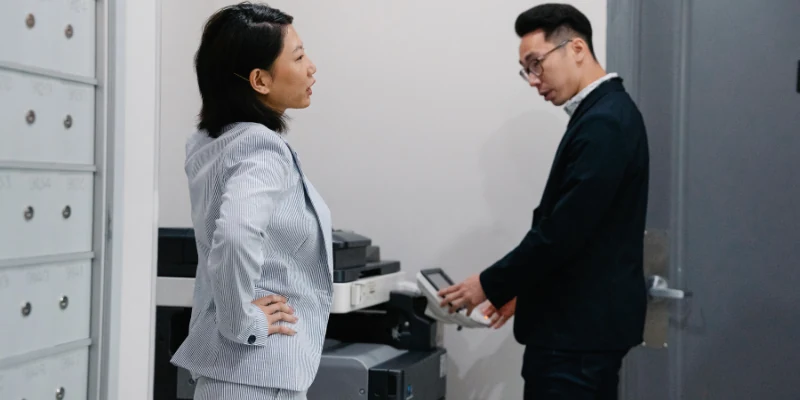Uses of Printers in Offices Boost Productivity Daily
Published: 9 Apr 2025
Do offices even need printers anymore? With everything shifting to digital, it’s easy to think that printing is outdated. However, many businesses still rely on physical documents for contracts, invoices, reports, and marketing materials. In fact, some industries, like law firms and healthcare offices, must maintain hard copies for compliance reasons. Plus, not all employees find digital screens convenient for reviewing important documents. From client proposals to shipping labels, printers remain a critical tool in modern offices. But what exactly are the uses of printers in offices, and how do they improve productivity? Let’s find out.
Printing Documents
Offices rely on printers to produce contracts, invoices, reports, and presentations. These printed documents are often used for client meetings, internal discussions, and official records. Hard copies are easier to read, annotate, and share, especially in industries that require signed paperwork. Many offices also print monthly financial statements for accounting purposes. Despite digital document sharing, printing remains a reliable and preferred method for essential paperwork.
Scanning and Copying
Many modern offices use multifunction printers that can scan, copy, and fax documents. Scanning allows businesses to convert physical files into digital formats, reducing paper clutter and improving storage efficiency. Copies of important documents are often needed for team discussions, backups, and official submissions. HR departments, for example, use scanned copies of employee records to maintain digital databases. This feature is crucial for businesses looking to balance physical and digital documentation.

Marketing Materials
Printers are widely used to create flyers, brochures, business cards, and posters for marketing campaigns. Printed promotional materials help businesses reach potential customers at events, conferences, and retail locations. High-quality printed content enhances brand visibility and makes a lasting impression. Many companies prefer in-house printing of marketing materials to reduce costs and maintain design consistency. Even with digital ads, print marketing remains a valuable tool for businesses.
Legal and Compliance Documents
Many businesses, especially in the legal, healthcare, and finance sectors, must maintain physical records for compliance reasons. Signed agreements, policies, and regulatory paperwork often require hard copies for audits and legal purposes. Government agencies and law firms, for example, rely on physical documents for their day-to-day operations. Having printed backups ensures important files are always accessible, even in case of system failures. Printers help offices meet legal requirements and maintain organized records.
Label and Receipt Printing
Offices in retail, logistics, and e-commerce use specialized printers to print labels, barcodes, and receipts. Shipping departments rely on label printers to generate clear, durable shipping labels for packages. Retail stores print customer receipts for purchase verification and returns. Businesses that handle inventory management also print barcodes for product tracking. These printers help companies streamline transactions and organize logistics efficiently.

Employee Productivity
Having a printer in the office allows employees to quickly print meeting agendas, reference materials, and reports. Not all employees prefer reading from screens, and printed documents help with better focus and retention. In fast-paced workplaces, a printer ensures that important materials are easily accessible without relying on digital devices. It also helps reduce screen fatigue, which can impact productivity over time. Offices with shared printers improve collaboration and workflow efficiency.
Wireless Printing
Wireless printing allows employees to print from laptops, tablets, and smartphones, improving flexibility in the workplace. This feature is especially useful in co-working spaces or large offices where multiple employees need access to a single printer. It eliminates the hassle of connecting cables and improves accessibility for remote workers. Many modern printers support cloud printing, allowing users to send documents to print from anywhere. Wireless printing enhances convenience and teamwork in the office.
Custom Stationery
Businesses often print letterheads, branded envelopes, and personalized memos for official use. Custom stationery enhances professionalism and strengthens brand identity in client communications. Printed internal documents, such as company guidelines and notices, create a sense of consistency within the office. Many companies prefer in-house printing for these materials to maintain quality and branding standards. Custom-printed stationery helps businesses leave a professional impression on clients and partners.

Training Materials
Offices regularly print employee training manuals, onboarding guides, and instructional handouts. Printed materials help new employees quickly understand company policies and procedures. Some industries, like healthcare and IT, require printed technical manuals and safety guidelines for easy reference. Physical copies are often more effective for learning and note-taking compared to digital versions. Providing printed training materials ensures employees have access to essential information anytime.
Event and Conference Needs
Offices that host meetings, conferences, or corporate events need printers to create name tags, event schedules, and handouts. Printed materials help attendees stay informed and navigate the event smoothly. Companies also print presentation slides, feedback forms, and promotional banners for business events. A well-prepared office uses printers to ensure professional and organized event execution. Having printed resources at an event improves engagement and communication with participants.
It depends on your needs! Laser printers are great for fast, high-volume printing, while inkjet printers work well for color-rich documents. If you need scanning, copying, and faxing, a multifunction printer is the best choice.
Use duplex printing (double-sided), set printers to draft mode for less ink usage, and buy high-yield cartridges. Going paperless for certain tasks can also help. Choosing an energy-efficient printer saves money in the long run.
Many businesses need hard copies for contracts, legal documents, and record-keeping. Printed materials are easier to read in meetings and prevent digital distractions. Some industries require physical paperwork for compliance reasons.
Inkjet printers use liquid ink and are great for color prints and photos. Laser printers use toner and are best for fast, high-volume, black-and-white printing. Offices needing sharp text and speed usually prefer laser printers.
Regular cleaning and servicing can prevent paper jams and ink smudges. It’s best to check and clean the printer every few weeks, especially in high-use offices. Replacing toner, ink, and parts on time keeps it running smoothly.
Yes! Many multifunction printers allow scanning, copying, and faxing. Some businesses also use printers for labels, barcodes, and promotional materials.
Consider speed (pages per minute), print quality, cost per page, and extra features like wireless printing or scanning. If multiple employees need access, choose a network printer. Automatic duplex printing can also save paper.
Use password-protected printing for sensitive documents. Limit access to only authorized employees and update the printer’s firmware regularly. Secure printers on a private network to avoid cyber threats.
Yes, wireless printing allows employees to print from any device without connecting cables. It helps in shared office spaces and reduces clutter. Just make sure the Wi-Fi connection is secure for safety.
While many businesses use digital solutions, a completely paperless office is difficult for legal, financial, and HR departments. Some documents still require physical signatures or hard copies for compliance. A balanced approach, printing only when necessary, is the best solution.
Conclusion
Printers continue to play a vital role in office environments, making daily tasks more efficient and organized. Whether it’s printing contracts, marketing materials, or essential records, they help businesses operate smoothly. Choosing the right printer can save time, reduce costs, and improve workflow. While digital tools are important, printers offer reliability that screens sometimes can’t match.

- Be Respectful
- Stay Relevant
- Stay Positive
- True Feedback
- Encourage Discussion
- Avoid Spamming
- No Fake News
- Don't Copy-Paste
- No Personal Attacks

- Be Respectful
- Stay Relevant
- Stay Positive
- True Feedback
- Encourage Discussion
- Avoid Spamming
- No Fake News
- Don't Copy-Paste
- No Personal Attacks
